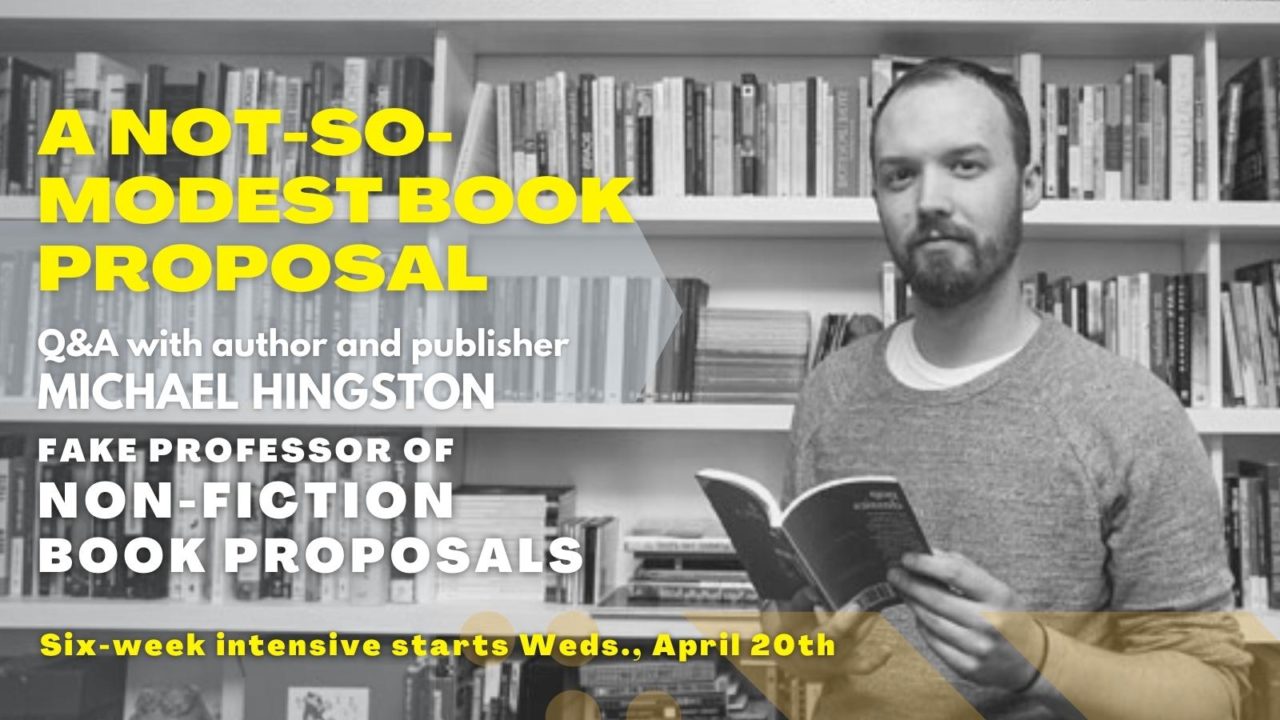Michael Hingston knows a thing or two about book proposals. The author and publisher has written quite a few—some successful in landing an agent but not a publisher; some successful in getting a book deal without an agent; and some that just were well written but not well timed.
Never one to let hard work go to waste, Michael shares some of them on his blog as guides to writing nonfiction book proposals. They’ve become so popular that even ECW Press’s submission guidelines direct nonfiction writers to one of his sample proposals.
It’s also why Pandemic U reached out to him back in spring 2020, as we were launching, to teach a class on the subject — a session viewed by well over 100 writers — and why we recruited him again two years later to offer an exclusive six-week intensive called The Art of the Nonfiction Book Proposal.
Starting Wednesday, April 20th, the author of Let’s Go Exploring, a history of Calvin and Hobbes, and the forthcoming literary saga Try Not to Be Strange will help 16 writers develop their own nonfiction book proposals from start to finish. (There are only six spots remaining. Email us if you have any questions or to request a payment plan.)
Leading up to his course, we asked him for some tips on how to capture the attention of agents and publishers.
What’s a common misconception that aspiring authors have about book proposals?
I’m not sure they misunderstand one particular thing about proposals so much as the fact that they exist at all. A lot of people think, “Easy! You write the book and then you sell it.” But for non-fiction, there’s this mysterious in-between stage, and that is the book proposal. It might sound like extra work, but knowing what proposals are and how they work is actually going to save you a lot of time and energy in the end, because this way you won’t spend months researching and writing material that your editor later decides should be cut from the manuscript entirely.
When should an author begin creating their book proposal during the writing process?
The best time to write a proposal is when you know enough to see the entire outline of the project, but not necessarily be able to fill in every last detail. It’s always a balance, and varies a little for each project, but you should be able to know what you know, and also know what you don’t yet know. Generally you should be able to describe your main characters, your setting, the main ideas being explored (and their significance), and the general arc of the story, as well as—and this is perhaps most important of all—the voice that you plan to tell the story with.
It might sound like extra work, but knowing what proposals are and how they work is actually going to save you a lot of time and energy in the end.
Tell us about one of your steepest learning curves while writing a book proposal?
Underestimating the sheer amount of time it can take to perfect them. The first time I tried writing a non-fiction book proposal, I figured I’d bang it out in a week. In reality, it took several months before I was happy with it, because every detail matters and you only get one chance to make a good first impression. One of the things I’m excited about with this course is helping students get past some of those initial hurdles a lot quicker than I did, and help them get to the point where they’re ready to start pitching as fast as possible.
What is the best piece of advice you’ve received about creating successful book proposals?
It’s the same advice I was given early on in my career as a journalist: all writing is seduction. This means that every piece of your proposal should be helping convince your reader that your book deserves to be published, and that you deserve to write it. There’s no room for flowery descriptions or idle guesswork. An acquiring editor is going to be putting money behind your project, so your job in the proposal is to convince them that it’s going to be money well spent.
How has your book proposal process evolved over the years?
Knowing the main sections in a proposal (which we will go over in detail, one by one) has drastically sped up my own process. It’s always a little different, depending on the project and the publisher/agent I’m talking to, but I now feel confident that I’m always working off of a reliable skeleton. That allows me to not stress out about structure and instead focus on the heartbeat of the story I want to tell.
Are you interested in taking Michael’s course? Here’s what you need to know!
COURSE SCHEDULE: Wednesdays, April 20–May 25, 2022, 7pm–9pm ET (4pm–6pm Pacific)
Award-winning author Michael Hingston has written many of these proposals over the years. In this course, he’ll teach you all of the pieces that make up this elusive document—from the overview to market research to the table of contents—and then help you write your own proposal that will make your idea shine. Through lectures, roundtable discussions, real-world examples, and personalized written feedback from Michael, you will gain a variety of knowledge about book proposals and the publishing industry as a whole.
In addition to receiving feedback on your proposal, his lectures will cover:
- What a non-fiction book proposal is, and how they work
- The art of selecting a title
- How to sell yourself and not just your book idea
- How to craft a perfect table of contents
- How to find and write the best sample chapter
- How to pitch your proposal
CAPACITY: 16 students (6 spots remaining)
RECOMMENDED PREREQUISITE: This course is intended for experienced, committed students. Students should arrive to the first class with an idea for a non-fiction book already in mind. If you’re unsure whether this course is for you, ask us at info@pandemicuniversity.com.

